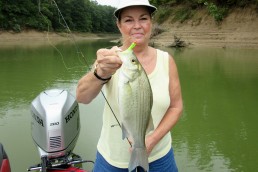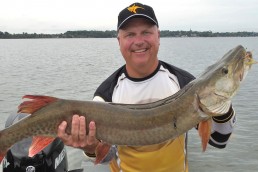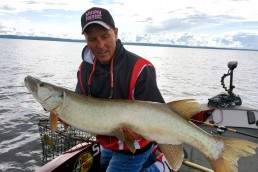Go Shallow at Turnover
SHARE THIS POST
We were fishing weed edges casting crankbaits for several hours, but to no avail. I just couldn’t figure out what was happening. The weekend before there were a bunch of muskies hanging along weed edges and they were chowing down on DepthRaiders. However, it seemed now as if they had just vanished from the lake. We tried several spots—and still nothing.
Finally, toward evening my friend started bombing a TopRaider over the shallow weed cover. In the last hour he had a follow, a blow-up and even caught one. We were happy to have caught one that day, but I still wasn’t sure where the bulk of the muskies were.
The next day we started fishing the weed edges. The wind was much stronger and the boat got closer to the cover than I normally would like. My partner fired a bucktail toward the shallow cover, and as soon as it hit the water, the battle was on and we boated a muskie.
Then the lightbulb finally went off—the muskies were in shallow cover.
I moved the boat tighter to the cover and we boated three other fish that day, all from the shallow weeds. In a matter of a week, the muskies had moved from the edge to the shallow flats and into thick cover. It took me a while to realize what was happening, but I never forgot it.
That scenario occurred over 20 years ago, but it burned in my memory bank as a solution to turnover muskies and how to adapt to muskie fishing in September.
Are you enjoying this post?
You can be among the first to get the latest info on where to go, what to use and how to use it!
All across the muskie range, fishing this month is during a time of transition. Water temperatures are on the decline and in many northern waters the thermocline is beginning to break down with the fall mixing, resulting in what is commonly known as fall turnover.
There are solutions to fishing muskies in this period, such as fishing shallower lakes that don’t stratify, or just fishing rivers. However, that doesn’t mean you can’t catch muskies from waters experiencing the fall turnover. The key to catching them now is to move ultra-shallow and look for either the thickest cover or to look more on the insides of the weedlines.
So, this September, pick a lake with some stain in the water, shallow weed cover. And if there are a few areas that have a distinct inside edge between the shallow docks and sand to the weeds, that makes that lake a better choice. In the early morning, check the inside weedline with topwater and bucktails. As the sun warms the shallow cover, you’ll find those muskies in that shallow cover heating up. The think weed cover almost acts like a heat source and you’ll them in the weeds during the day. Get tighter to the cover and fish spinnerbaits, such as Slopmasters, for topwater over and through the cover. Fish shallow minnow baits in the weed pockets.
On any water, you’ll notice certain weed beds holding more fish. It might be they are protected from the wind and absorb more sunlight or it could be the opposite and that the wind is blowing into them and activating muskies. Regardless, try and replicate the pattern in other sections of the lake. Over time, you will learn the best inside weedline spots and the top weed beds that consistently produce this species. Once you have determined these spots, it’s a matter of slowing down and fishing these areas thoroughly. I don’t really run and gun during turnover, but try to focus on a few key areas and beat them to death.
September is a transition month and the beginning of what some consider some of the best muskie fishing of the year. Get shallow, fish topwater and spinnerbaits, and you’ll likely catch them.
MWO
SHARE THIS POST
Did you enjoy this post?
You can be among the first to get the latest info on where to go, what to use and how to use it!
Jim Saric
Jim Saric is a Legendary Angler in the Freshwater Fishing Hall of Fame, the host and executive producer of The Musky Hunter television series, editor at large of Musky Hunter magazine, a seven-time muskie tournament winner, and a contributing writer for numerous other publications.



